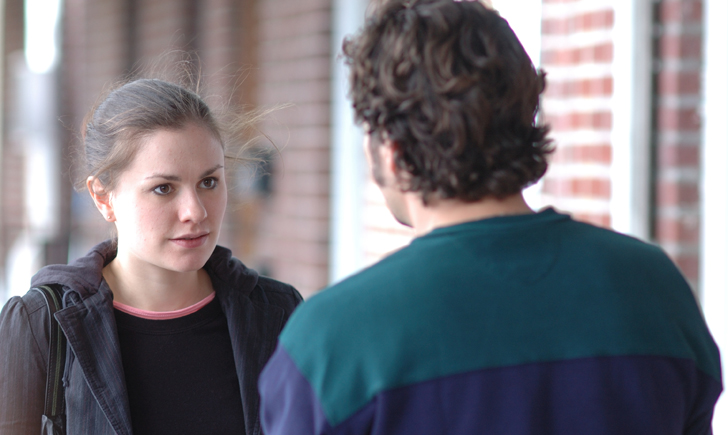Calatrava’s Quadracci Pavilion from the South. Photo by davehearse’s photostream
“He rises!” — Gregory Peck, as Captain Ahab in John Huston’s Moby-Dick*
MILWAUKEE — There are very few buildings in the world to which Ahab’s phrase could be applied, after a building “rises” as a construction project. But the fateful utterance befits Santiago Calatrava’s Quadracci Pavilion for the Milwaukee Art Museum almost every noon, when the extraordinary building’s signature brise soleil sunscreen wings rise and open, to perpetual wonder.
I have seen the structure close-up frequently on bike trips to the building this summer, and I realized that the season is a perfect time for fresh appreciation of an architectural masterpiece for our times.
After all, in summer the public travels past, through and underneath the amazingly dynamic structure, as sunlight and lake water highlight its glories of profile, depth and presence. Thousands of visitors also come to the lakefront festival grounds just south of the museum, for the world’s largest music festival Summerfest, and Milwaukee’s array of ethnic festivals.
Calatrava’s design “evolved into a very challenging building, full of curves requiring painstaking custom work and features that had never before been made for building,” writes Cheryl Kent in her book Santiago Calatrava: Milwaukee Art Museum Quadracci Pavilion. It is an audacious balance of sculpture and architecture, engineering and symbolic power.
Because, as Kent suggests, the pavilion transcends the conventional category of a mere building, it invites the perceptual imagination to take a voyage with it — part of the reason why it is such a perfect building to house creative art. This building seems to breathe with life, to a degree matched only to designs by Frank Gehry, perhaps the only other contemporary architect to rival Calatrava now with superstar status among the general public.
But what spurred my blog posting was the sight of the Calatrava from the Southerly perspective, as I turn my bike around to head back north toward my home in Riverwest. I saw something in the building I hadn’t noticed before, a relationship between the facets of its major features that sprang to life in a work already rich in symbolic resonance.
This vantage point allowed the tallest part of the structure to make metaphorical sense. Behind the pavilion’s main structure stands the great diagonally pitched pole, which secures long suspension cables for the pedestrian bridge, from the downtown to the pavilion entrance. As I look, the severely leaning pole evokes the main mast of a sinking ship. Accordingly the lower white sides of the main structure resemble the hull of a ship with flaring stern and bow.
Kent has termed the very front of the pavilion facing the lake, as “a cantilevered ‘prow’ that draws visitors inexorably with the sensational view of Lake Michigan.”
But what famously sinking ship do we think of? The Pequod, of course, captained by the monomaniacal Ahab, who led his entire crew, save one, to doom. And the ship is sinking, of course, because of the explosive monster that surges up triumphantly just ahead of the tottering mast, after having rammed it.
The more you look at this building, in this sense, the more whale-like it becomes, especially the area beneath the long horizontal “ship deck” railing. This lower configuration is a widely flaring section with buttresses supporting a balcony that shades large lower windows. The whole darker form resembles the horizontal shape of a captured whale — to almost exact scale and proportion – hooked up alongside a whaler to be stripped to its skeleton for its blubber, and the prized spermaceti, in the case of Moby Dick’s sperm whale species (see photo at top).
So, upwards we go to the climactic moment, where the brise soleil calls for a slight imaginative leap to extend the whale metaphor. But as the rising wings move skyward one can envision the long, white wing-like fins of the humpback whale, captured in a time-lapse sequence on film. Just below the wings, the brise soleil’s impossibly long blue-green windows fall from the central backbone like the sea itself, cascading off the body of the breaching whale.
If one still questions the aptness of this creaturely metaphor, consider the most obvious alternative. The wing-like brise soleil is often compared to a giant bird, but no bird of this scale ever existed, whereas the building’s proportions do come close to those of a whale, or no other creature.
And the unconvinced should step inside the building where its cetological qualities expand like a giant inhaling ribcage. The bone-white flying buttresses that curve over the long hallways extending along outside the east and west lengths of the Quadracci Pavilion’s galleries and gift shop resemble the ribs of only one creature, that of a whale.
One of the long butressed hallways outside the galleries of the pavilion. This photo and the one below are by Mary Ann Sullivan c 2002
So in these hallways and in the main foyer, one gets a Jonah-like sense of being inside of a whale. Standing in the cavernous 90-foot-high Windhover Hall and peering up, one seems to witness — from within — a mighty whale breaching skyward.
Windhover Hall, the pavilion’s foyer.
As Kent notes, descriptive nomenclature sprang up among those working on the construction project to identify pieces in the building: they need certain parts of the ‘wishbone,’ the ‘fishbowl,’ and the ‘hammerhead…’” So allusions to organic aquatic forms arose even during the construction. One can easily imagine the architect playing with aquatic symbols as he designed his masterpiece to overlook one of the Great Lakes. Calatrava appears to have extended this creation into the vast and profound legacy of what many consider the Great American Novel, and a great allegorical story of America.
Given all this, a good idea for an art exhibit here would be a gathering of the profusion of visual art that has been inspired by Moby-Dick. In fact, the catalog already exists: Elizabeth A. Schultz’s masterful Unpainted to the Last: Moby-Dick and Twentieth-century American Art.
The coffee-table sized book delineates illustrations for notable editions of Moby-Dick, including those of Rockwell Kent, Boardman Robinson and Barry Moser; the surprising array of abstract expressionist paintings and sculptures including work of Jackson Pollock, Sam Francis, Theodore Stamos, Paul Jenkins, and Frank Stella; narrative and realistic representations of Moby-Dick by artists including Jean-Michel Basquiat, Robert del Tredici, Maurice Sendak and Robert Indiana; various political cartoonists and arguably today’s most prominent and controversial sculptor, Richard Serra, who created in 1986 a whale-shaped and sized steel work titled Call Me Ishmael.
Given the often-long lead time for curating and scheduling major exhibits, a good target date for such an exhibit might be 2019, which would be the 160th anniversary of Melville’s visit to Milwaukee, when he delivered a lecture on life in the South Seas on Feb 25, 1859, based on his adventurers as a whaler.
Which leads us back to the actual ocean of Melville’s imagination. Recall this blog’s epigraph. The phrase “he rises” does not appear in the original Moby-Dick text during the climax of the long-awaited confrontation with White Whale. It was written for the 1957 screenplay version, by director John Huston and writer Ray Bradbury. In Melville’s book, the boat crew together beats Ahab to the call:
“’There she breaches! there she breaches!’ was the cry, as in his immeasurable bravados the White Whale tossed himself salmon-like to Heaven.”
Santiago Calatrava’s architectural bravado seems worthy of Melville’s description.
______________________________
http://www.flickr.com/photos/overbythere/5614303727/sizes/o/in/pool-1779525@N22/









